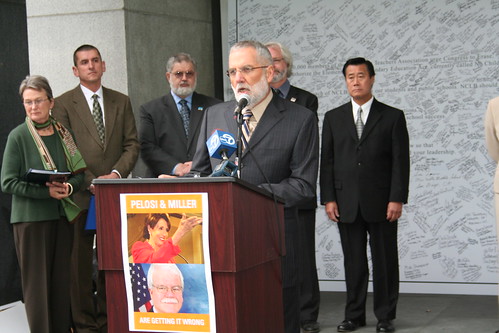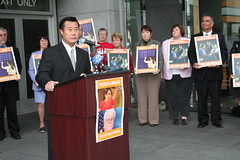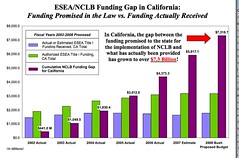 (full disclosure: California Teacher’s Association has hired me to do online outreach on NCLB)
(full disclosure: California Teacher’s Association has hired me to do online outreach on NCLB)
x-posted on dkos
There are a lot of things wrong with NCLB, so why are George Miller and Nancy Pelosi insisting on adding new problems. More specifically, adding a federal merit pay program for teachers. First of all, studies have shown that merit pay just does not work. It leads to divisiveness in the teaching ranks, makes hiring more difficult and tends to go to teachers in affluent school districts, despite promises to the contrary. Just about every school that implements merit pay repeals it down the road.
This is not an isolated problem:
Merit pay comes in many forms and flavors — including extra bonuses for student achievement gains, satisfactory evaluations by principals or committees, acquiring additional duties, gaining new skills and knowledge, and serving in hard-to-staff schools. We’ve looked at dozens of plans in North America, South America, Asia, Europe, and the Middle East. Guess what? None of them, past and present, has ever had a successful track record. None has ever produced its intended results. Any gains have been minimal, short-lived, and expensive to achieve.
That was from an article in the Boston Globe by two education experts. Yet, still Miller persists on pushing this federal program.
Take for example what is going on in Florida. They passed a merit pay program and promised that there would be no imbalances along racial or income lines. That was the problem with a now defunct earlier problem and the problems are still the same with this new program.
At Palm Lake Elementary, two out of three teachers earned a bonus through Orange County Public Schools’ merit-pay plan.
At Richmond Heights Elementary, the number was zero.
Palm Lake is a predominantly white school in the affluent Dr. Phillips area.
Richmond Heights is a predominantly black school in a poverty-stricken pocket of Orlando.
The two schools illustrate a marked disparity in the distribution of merit bonuses to 3,911 Orange County teachers and administrators uncovered in an Orlando Sentinel analysis of the program.
The Sentinel’s review showed that teachers at predominantly white and affluent schools were twice as likely to get a bonus as teachers from schools that are predominantly black and poor.
The merit pay program in the Miller/Pelosi program was the topic of some controversy during Monday’s hearing. Miller accused teachers, in specific NEA, of reversing themselves on merit pay. At issue was an earlier bill, which NEA reluctantly supported back in 2005 called the TEACH Act.
Toward the end of the almost seven-hour session, NEA President Reg Weaver and AFT Executive Vice President Antonia Cortese objected to proposed alternative pay programs for teachers, which are included in the section addressing teacher quality.
In the Q&A that followed, Chairman George Miller, D-Calif., reminded the union reps that that the pay proposals came from the Teacher Excellence for All Children Act, which the unions endorsed after extensive talks with Rep. Miller and a host of education groups.
“This language was mutually arrived at by various parties,” Rep. Miller said.
In response NEA President Reg Weaver sent a letter to the members of the Education Committe, Nancy Pelosi and George Miller. This is an excerpt from the Miller letter:
In May 2005, prior to the introduction of the TEACH Act, we expressed our concerns in writing to your staff about performance-pay provisions contained in the draft bill, calling for them to be subject to collective bargaining or a 75 percent majority support vote of teachers where bargaining does not exist. Ultimately, the introduced bill did include some labor protections. However, as we stated in our letter of June 2005, we looked forward to continued work with you on making improvements to the bill. We offered your TEACH Act legislation general support because the bulk of the bill was aimed at providing teachers with the kinds of supports they need to be successful, such as high quality professional development, mentoring and induction programs, and incentives to become certified by the National Board for Professional Teaching Standards. You are an experienced legislator who understands that “general support” does not translate to support for each and every provision of a particular bill. If that were the case, we would never see passage of most pieces of legislation and legislators would never receive letters of support from interested parties.
They supported the bill at the time, with reservations, with the understanding that they would work on improvements because the larger goals were important. That does not mean that they endorsed the concept of merit pay, particularly as laid out in the current Miller/Pelosi proposal.
After that initial support and earlier this year when Miller’s staff informed them that they would be re-introducing the TEACH act and making it the basis for the re-authorization of NCLB/ESEA, NEA re-informed Miller of their opposition in discussions with his staff. They sent letters and continued discussions. More from the letter:
On August 8 and again on August 16, NEA sent letters (attached) to convey very clearly our position about performance pay plans. At the end of August and over the Labor Day weekend, NEA staff submitted additional legislative language to remedy the serious problems in your draft language; however, those proposals were rejected. Your discussion draft released on September 6 reflects neither the specifications set forth in our letters, nor the legislative language suggestions we have proposed to protect educators’ rights. Furthermore, the Title II discussion draft now contains additional performance pay provisions that were not a part of the TEACH Act (such as in the Teacher Corps program).
Miller knew full well that they opposed the merit pay provisions. Any suggestions to the contrary are just silly. Did they need to take out ads to make it clearer?
To reiterate, we do not support mandating any evaluation or compensation term as an element of a federal program, voluntary or not. We are particularly opposed to any provisions that would require that student test scores be a mandatory element. Therefore, we are simply asking again for labor protections to ensure that a school district cannot impose on teachers without their consent the use of test scores or student learning gains as part of any evaluation or compensation system. As several of your witnesses testified yesterday, educator buy-in is essential to the success of any compensation plan.
We are determined to obtain clear and comprehensive protections in ESEA concerning any aspect of teacher compensation, evaluation, or other employment terms. As I indicated yesterday, our members are hired by school districts, not the federal government. As such, employment contracts must be negotiated and agreed to at the local-not federal-level. This issue, more broadly, is about protecting public employees’ collective bargaining rights under federal law. We will not support any legislation that undermines those rights and sets a dangerous precedent for our colleagues in the labor community.
It is not that teachers oppose any and all pay-for-performance legislation. The crux of it is that it doesn’t happen with out their approval, it should be one of several options for using federal funding and it does not undermine local bargaining agreements.
New federally mandated programs, especially those that are proven not to work are not what we want from the new NCLB bill. We need to fix the problems that currently exist, not create new ones, especially ones that are based on test scores. George Miller needs to stop playing dumb on this one. Teachers do not support this merit pay program, they never have. They have not reversed themselves. It was always a bad idea and it will always continue to be a bad one.
Take Action, contact Miller and Pelosi. More information on the CTA website.






